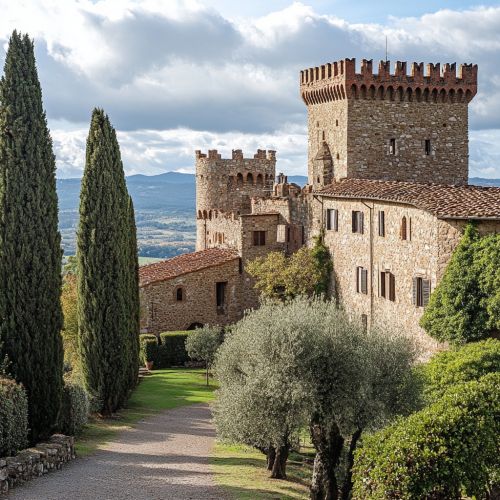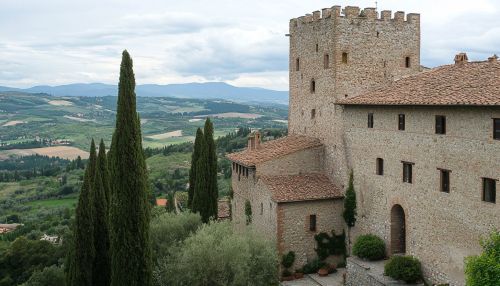Malaspina Castle: Difference between revisions
No edit summary |
No edit summary |
||
| Line 9: | Line 9: | ||
In the Renaissance period, the castle underwent significant architectural modifications. The Malaspina family commissioned renowned architects and artists to enhance the castle's aesthetic appeal. The addition of elegant frescoes, intricate woodwork, and ornate decorations transformed the fortress into a luxurious residence. | In the Renaissance period, the castle underwent significant architectural modifications. The Malaspina family commissioned renowned architects and artists to enhance the castle's aesthetic appeal. The addition of elegant frescoes, intricate woodwork, and ornate decorations transformed the fortress into a luxurious residence. | ||
[[Image:Detail-98117.jpg|thumb|center|Malaspina Castle in Fosdinovo, Tuscany, Italy, with its medieval architecture and surrounding landscape.]] | [[Image:Detail-98117.jpg|thumb|center|Malaspina Castle in Fosdinovo, Tuscany, Italy, with its medieval architecture and surrounding landscape.|class=only_on_mobile]] | ||
[[Image:Detail-98118.jpg|thumb|center|Malaspina Castle in Fosdinovo, Tuscany, Italy, with its medieval architecture and surrounding landscape.|class=only_on_desktop]] | |||
== Architecture == | == Architecture == | ||
Latest revision as of 17:36, 25 September 2024
History
Malaspina Castle, situated in the town of Fosdinovo in the province of Massa and Carrara, Tuscany, Italy, is a historic fortress with a rich and varied history. The castle's origins date back to the 11th century, and it has undergone numerous transformations and renovations over the centuries. The Malaspina family, a noble lineage known for their influence and power in the region, played a significant role in the castle's history.
The castle was initially constructed as a defensive stronghold to protect the surrounding territory from invasions and conflicts. Over time, it evolved into a residential palace, reflecting the changing needs and aspirations of its occupants. The Malaspina family, who were originally feudal lords, transformed the castle into a symbol of their wealth and status.
During the Middle Ages, the castle was a focal point of power struggles and territorial disputes. It witnessed numerous battles and sieges, with various factions vying for control. The strategic location of the castle made it a coveted prize for both local and foreign powers.
In the Renaissance period, the castle underwent significant architectural modifications. The Malaspina family commissioned renowned architects and artists to enhance the castle's aesthetic appeal. The addition of elegant frescoes, intricate woodwork, and ornate decorations transformed the fortress into a luxurious residence.


Architecture
Malaspina Castle is an exemplary model of medieval and Renaissance architecture. The structure is characterized by its robust stone walls, imposing towers, and fortified gates. The castle's design reflects its dual purpose as both a defensive stronghold and a noble residence.
The main entrance is flanked by two massive towers, which served as lookout points and defensive positions. The walls are punctuated with narrow slit windows, known as arrow slits, which allowed archers to defend the castle while remaining protected.
The interior of the castle is equally impressive, with a series of grand halls, private chambers, and courtyards. The Great Hall, the centerpiece of the castle, features a vaulted ceiling adorned with frescoes depicting scenes from classical mythology and the history of the Malaspina family. The hall was used for banquets, ceremonies, and gatherings, showcasing the family's wealth and influence.
The private chambers of the castle are decorated with intricate woodwork, tapestries, and period furniture. These rooms provide a glimpse into the daily life of the castle's inhabitants and their refined tastes.
The castle also includes a chapel, which was an essential feature of noble residences during the medieval period. The chapel is adorned with religious frescoes and served as a place of worship for the castle's residents and guests.
Strategic Importance
The strategic importance of Malaspina Castle cannot be overstated. Its location on a hilltop provided a commanding view of the surrounding landscape, allowing its occupants to monitor and control the region. The castle's fortifications were designed to withstand prolonged sieges and attacks, making it a formidable defensive structure.
The castle's position along key trade routes also contributed to its significance. It served as a checkpoint for merchants and travelers, allowing the Malaspina family to exert control over commerce and collect tolls. This strategic advantage bolstered the family's economic power and influence.
Throughout its history, the castle played a crucial role in regional politics and military campaigns. It was a base of operations for various military expeditions and a refuge during times of conflict. The castle's ability to withstand sieges and its strategic location made it a valuable asset for any power seeking to control the region.
Cultural Significance
Malaspina Castle is not only a historical and architectural landmark but also a cultural treasure. The castle has been the subject of numerous legends, stories, and artistic works. Its association with the Malaspina family, known for their patronage of the arts, has contributed to its cultural significance.
The castle's frescoes and decorations are a testament to the artistic achievements of the Renaissance period. The works of art within the castle reflect the tastes and interests of the Malaspina family, who were known for their appreciation of literature, music, and visual arts.
The castle has also been featured in various literary works and historical accounts. Its storied past and dramatic setting have inspired writers, historians, and artists. The legends and myths associated with the castle add to its allure and mystique.
Preservation and Restoration
The preservation and restoration of Malaspina Castle have been ongoing efforts to maintain its historical and architectural integrity. Over the centuries, the castle has faced numerous challenges, including natural decay, war damage, and neglect. However, dedicated efforts by historians, architects, and conservationists have ensured the castle's survival.
Restoration projects have focused on stabilizing the structure, preserving original features, and restoring damaged artwork. Modern techniques and materials have been used to reinforce the castle's walls and foundations, ensuring its longevity.
The castle is now a popular tourist destination, attracting visitors from around the world. Guided tours provide insights into the castle's history, architecture, and cultural significance. The preservation efforts have made it possible for future generations to appreciate and learn from this remarkable historical site.
See Also
- Medieval Architecture
- Renaissance Art
- Feudalism in Europe
- Italian Noble Families
- Historic Preservation
